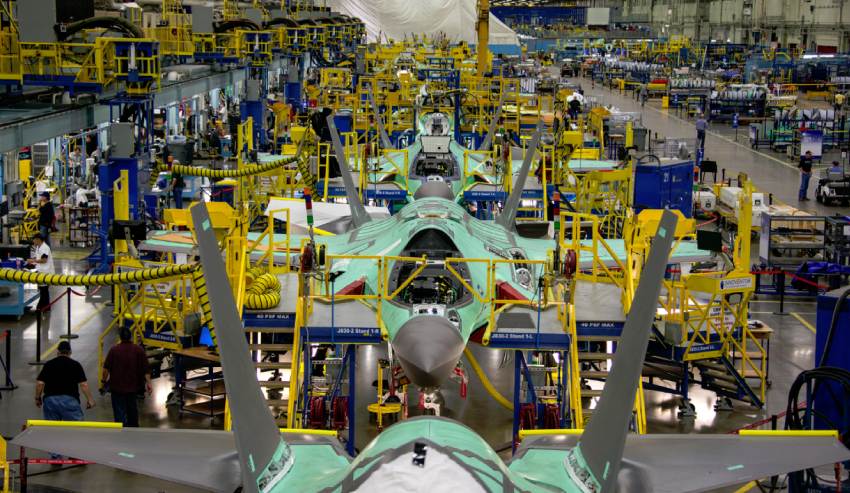
F-35s on Lockheed Martin’s production line
UPDATED: To include latest expectations on cost reduction. FORT WORTH: Lockheed Martin and DoD’s F-35 Joint Program Office are likely to sign a six month stop-gap sustainment contract to provide administrative authority for work to continue while they negotiate a longer-term contract, according to company officials.
Meanwhile, the company expects to pump out up to 139 Joint Strike Fighters in 2021, Bridget Lauderdale, the company’s new F-35 program head, told reporters today at Lockheed Martin’s F-35 production facility in Fort Worth. That would mark an increase of 19 from 2020.
Lauderdale, said the firm kicked out 120 aircraft last year despite the pandemic. “As we look forward here in 2021, we anticipate delivering between 133 and 139 aircraft on the process of recovering from the disruption and COVID, and we’re in the midst of having a [discussion] with our Joint Program Office customer on defining what that rate looks like going forward.”
The F-35 prime contractor has been working since late last year under what is known as an ‘undefinitized contract action’ covering sustainment for fiscal 2021, while negotiations on a formal contract are hammered out. While Lt. Gen. Eric Fick, JPO head, told lawmakers in April that the two sides were nearing a “handshake” deal to cover sustainment operations through 2023, the talks continue.
“You will see another undefinitized contract of work. It might even be another six months,” a Lockheed Martin official said today. “But that’s really just to cover sort of administrative gap, and make sure we don’t have a gap in coverage.”
Company officials are hopeful that the three-year sustainment deal will be wrapped up soon. Lockheed sees that contract, which comprises three one-year options, as a bridge to a hoped-for five-year performance-based logistics (PBL) deal starting in 2023. Since 2019, Lockheed Martin has been pushing DoD to change its current year-by-year contracting methodology for JSF sustainment by switching to a firm-fixed price, multi-year PBL that they insist will both cut the F-35’s maintenance costs and speed parts delivery. The PBL may be crucial to ensuring the US government and other countries buying F-35s continue to do so in substantial numbers.
Maintenance issues are driving much of the F-35’s sky-high sustainment costs. The Government Accountability Office has projected it to cost some $1.2 trillion over the fleet’s 66-year life time — costs that have crept steadily upward since the 2012 baseline. That sum would dwarf the up-front cost of R&D and procurement, bringing total life-cycle costs for the program to $1.6 trillion.
The stealth fighter’s cost per flying hour is about $33,000, according to Fick.
UPDATE BEGINS. Back in 2019, the program’s goal was to push that cost down to $25,000 by 2025, and both the JPO and the company were convinced it could be met — but that goal seems to be looking less likely. Fick didn’t exactly commit to that goal in his April testimony to House Armed Service Committee; rather said the sustainment deal through 2023 would “move us down that path.”
Still, Lockheed Martin officials are adamant on reducing O&S costs — “laser focused” in the words of Lauderdale and other officials. With the company’s continued investment in sustainment and a global fleet that is scaling up, officials have said they expect to reduce the cost per flying hour by another 40 percent over the next five years. UPDATE ENDS.
Meanwhile, Lockheed Martin is working to “smooth out” the rate of F-35 production, in the wake of delays caused by the COVID-19 pandemic. The effort is aimed at getting into a steady production rhythm over the next few years, company officials here told reporters today.
Lockheed Martin paid for Theresa’s trip to Fort Worth.
Navy jet trainer fleet operations remain paused after engine mishap
One week after the incident, a Navy spokesperson says the service is continuing to assess the fleet’s ability to safely resume flight.


























